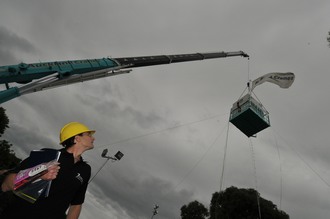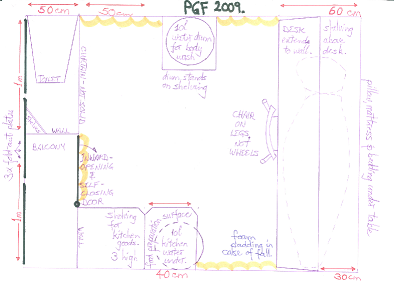Alastair Galpin
took to world record-breaking in
2004 after being inspired by a record-setting rally
driver in Kenya. What began as a hobby soon escalated
into an active publicity pursuit. Today, he promotes the
work of social and environmental causes. For these
purposes, the most fitting game plans are chosen; then
world titles are attempted and frequently created.
Sustaining sponsor
If you would like regular exposure from Alastair's activities, become his Sustaining Sponsor:
- A range of attempts annually
- Your brand in multiple media
- Distribute your own media releases
- Receive product endorsements
More details about sponsorship opportunities
Special thanks
|
Behind every world record attempt is the expertise of professionals in their field. Their success underpins Alastair's. |
| They are listed here |
Most radio interviews in suspended cage: 98
This is the story behind my world record for the Most radio interviews in a suspended cage.
Under normal circumstances, nobody would
volunteer to dangle from a crane in a caged public toilet over Easter.
If pressurised to do so, however, it'd be wise for the contender to
cope well with sea-sickness, not be scared of heights, and not have a
phobia of public toilets. But, as you probably know by now, I'm not
your average fellow. I can't hold my stomach for more than a few
minutes on a rocking boat, I don't like heights when I can avoid it,
and I'll do almost anything to avoid visiting a public toilet.
So why, one has to ask, would I be the one to
suggest this world record attempt? Because the opportunity arose, and I
wanted the attention for myself as well as for the social cause
associated: help for those affected by problem gambling. I thought it
was worth the effort, and I always will. Problem gamblers need to know
there's help.
It took approximately a year to set up this
event. There were tough times, like when the authorities would not let
plans progress without extensive hurdles being overcome. But the great
team of assistants I had overcame every challenge. Some of the planning
was fun too. It humoured many companies to hear of the plans and
think of ways to support it. Plans changed so many times to fit the
legal, safety and community aspects of the event, I wasn't always able
to keep up. In the end, we'd succeeded in arranging most things: a
portable public toilet that fitted into the man-cage for the crane, the
bare basics that anyone would need to live in a remote mountain hut
with, a computer for media contact, and an army of helpers to do just
about everything.
Finally, the big day in April came. The team
stuffed bags of belongings into the toilet and I slipped inside. After
some media attention and dozens of last-minute checks, I was secured
into my harness and the crane's engine hummed. Ooh! The cage began to
lift free of the ground and up I went as the wire rope spooled.
Initially, my heart was in my throat, but a few hours later I'd come to
terms with this: I'd either fall to my death or the Problem Gambling
Foundation of New Zealand would receive a great deal of media from my
being here.
 Thankfully,
the
latter
happened.
I
spent
almost
all
day
and
night,
every
day
and
night,
seeking
radio
interviews.
I
picked
up
live
and recorded chats from right around New Zealand and to
the furthest corners of the world: the Falkland Islands, Tenerife,
Guam, the Inner Hebrides, Belize and more. I did try the main operating
channel in Antarctica, but perhaps that scientific community had other
priorities. Several Arctic outposts and smaller nations in the high
latitudes were a struggle to make arrangements with because I'm limited
to English. So, alas, I had to foresake the opportunity with keen
presenters in these regions.
Thankfully,
the
latter
happened.
I
spent
almost
all
day
and
night,
every
day
and
night,
seeking
radio
interviews.
I
picked
up
live
and recorded chats from right around New Zealand and to
the furthest corners of the world: the Falkland Islands, Tenerife,
Guam, the Inner Hebrides, Belize and more. I did try the main operating
channel in Antarctica, but perhaps that scientific community had other
priorities. Several Arctic outposts and smaller nations in the high
latitudes were a struggle to make arrangements with because I'm limited
to English. So, alas, I had to foresake the opportunity with keen
presenters in these regions.
Back in Britain, though, things were humming. I
was getting feedback regularly that locals were calling in, grateful to
radio show hosts highlighting the problem gambling issue. People spoke
of their loved ones being affected, the related crime and their fears
of family insecurity. A number of talk groups emerged on air, and even
a few regular talk back shows! I was called by a number of radio
stations, wanting more chatter on the issue. This continued for my
three-week escapade. The UK was highly receptive of the need to face
gambling addiction.
Australia loved the concept of a stunt to
highlight the situation. I was asked for so many interviews, I got to
recognise presenters' voices when they called. As in the UK, I was told
of stories involving Australians reaching out for help, and their
motivation to assist others as a result of our New Zealand project.
Canada responded with similar fervour. It was
here I had my longest interview during the attempt – 45 minutes live.
The national broadcaster duplicated a recorded interview I did with
them, and I heard from friends across the country's time zones that I
was under discussion on various programmes. Then a prominent Canadian
university used this event as part of a message aimed at youth,
alerting them to potential addictive behaviours.
The international media was having a feast. It
went on and on. Some radio stations interviewed me almost a dozen
times, I ended up on countless news and entertainment websites, large
and small newspapers wrote articles, television channels ran stories in
numerous countries and magazines published spreads of my work –
including this event - afterwards.
I was exhausted and filthy when I emerged after 3
weeks. Everyone who'd been involved was happy, though, for the
achievement we'd all created. We even created a slideshow to depict the
record
attempt, from which you can see the conditions I had endured.
Yet, my administrative duties were only
about to begin; all world record claims must be supported by exhaustive
paperwork. For the next year, I'd be collecting data of all sorts in
preparation to send to the judges. During this time, psychologists in a
handful of countries took a brief interest in how living in this
confined space had affected me. Friends also commented that since
emerging, I'd changed permanently to a slightly more subdued type. I
wonder what the full mental ramifications of this undertaking have been
on my mental state?
And would you believe it, one day, when
attempting another world record, I was approached by an individual. He
was clasping a newspaper clipping of me in this cage. I was puzzled as
he pointed to it inquiringly. Then he asked how he could beat my
achievement. I was encouraging to this potential challenger, but was
stunned that he had chosen this as his very first world record to
attempt. I've never heard from him since.
See the record slideshow
The diagram below was my sketch as to how to fit everything into the small space which was to be home for the event - it reflects just how tight a squeeze it was.

